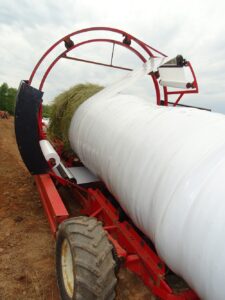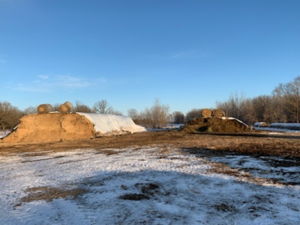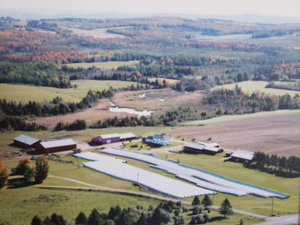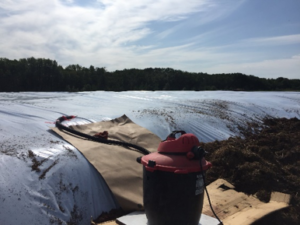Silage is Top Choice for These Three Beef Producers

Editor’s note: The following is part two of a two-part series that will help you to evaluate the advantages and disadvantages of silage production across Canada. Read part one on silage cost of production.
Many Canadian beef producers have been harvesting and feeding silage for decades, while others are relatively new to the practice. There are upsides to silage, including the ability to harvest forage during variable weather, being able to produce more feed on fewer acres, and the potential for a more economical feed ration. There are also drawbacks to consider, including additional feeding infrastructure and equipment investment. Also, as with any new method or management practice, producers considering silage need to do their homework, develop a new skillset and be prepared to adapt and adjust as they learn.
Read about the experiences of three beef farmers from across Canada who have incorporated silage on their farms.
Kevin Duddridge
Pansy, Manitoba
Kevin Duddridge describes silage as the “future of beef production” and has been relying on silage to feed his cow herd for the past five years. Duddridge and his family run a 220 head cow-calf operation that they started in 2003 and they feed a total mixed ration based on corn silage. “We don’t use dry bales at all because it’s hit and miss from year to year,” says Duddridge, who added that their cost of production has reduced since shifting away from dry hay. “Corn is an amazing plant. It has a root that will find water in dry years, and in years where conventional hay fails, you will still get a crop of corn,” Duddridge explains. “It’s basically half the price per pound of dry matter for our production costs,” he adds.
In the region of Manitoba where Duddridge farms, there typically isn’t a window of good weather to allow conventional hay to dry and cure so he also chops and ensiles their first cut of hay. “The beauty of haylage is that the earlier you can cut it, the higher the nutrient level is, and this way you can keep all your nutrients and eliminate the risk of putting up dry bales,” he says.
“The beauty of haylage is that the earlier you can cut it, the higher the nutrient level is, and this way you can keep all your nutrients and eliminate the risk of putting up dry bales.”
Kevin Duddridge
They test their feed ingredients to develop a complete ration by blending corn silage or (or both), cereal straw, and a protein source like canola or soybean meal. Duddridge also works with local farmers to bale corn stover residue that the farmers need removed from their fields. “Stover makes excellent bedding as well or a substitute to cereal straw,” he says. He chops and adds it to his ration as needed.
Duddridge hires custom silage operators and they pack the material in a pile that’s approximately 40’ wide and 300’ long. He covers the pile with plastic and weighs the edges down with composted manure from his corrals. “The pile gets pretty tight, and it’s a fantastic way to stretch the plastic down,” he describes.

Research suggests 65 per cent moisture is the optimal target for proper fermentation, although Duddridge has pushed the limit and harvested crops at lower moisture levels. “With corn you usually have a lot of flexibility as to when to chop it, there’s a wide window from the end of September to mid-October,” Duddridge says. He adds that you don’t want a product that is over 70% moisture, as that can lead to mold and toxin issues and increased spoilage.
Duddridge encourages producers who are interested in being in the beef industry long-term to look at the silage model compared to the traditional dry bale method of feeding a cow herd. “With silage, you can significantly reduce your feed costs and that’s your number one cost of production,” he concludes.
Jeff McAffee
Lower Knoxford, New Brunswick
Jeff McAffee works along with his family on a multi-generational family farm started by his father more than fifty years ago. They run a 200 head purebred Charolais operation and have been harvesting silage for about thirty seasons.
McAffee says that in his region, some years you can get dry hay but you can’t always count on the weather to cooperate. “Silage gives you the option to bale it faster and sooner,” he says. An added bonus of silage is that it is time efficient. “When you’re done wrapping silage, you’re done, whereas with dry hay, you bale and then you still have to go back and get it,” he says.

McAffee uses an inline wrapper to ensile his bales and says that after putting up silage for so long, they have a pretty good idea of the moisture level just by touch. “Our baler has a roto-chopper on it so as it’s baling, there is a spinner that’s pulling the product through these knives attached in the baler and it chops it up to be about 1” long,” he says. The bales are covered in netwrap and then the inline wrapper pushes bales end-to-end in a long, continuous row, simultaneously covering it with plastic. He finds there is less spoilage because of a reduced surface area from ensiling the bales in a row compared to individually wrapping bales.
McAffee maintains it is important to use adequate plastic for wrapping. “Plastic can get pricey,” he says, and adds that it may be tempting to skimp to save money but it’s not worth it. “Put on the extra plastic and you will have less spoilage,” McAffee says.
When it comes to selecting a crop, McAffee finds that clover has more nutritional value than straight timothy hay. “We usually put in a triple mix of both alsike and red clover with timothy,” he says. He prefers to feed the silage within the year it is produced but he has kept it over and fed in the following year when necessary. The silage bales are typically fed in round bale feeders however as their farm continues to adapt, they recently added a feed mixer that will enable them to incorporate their silage into a total mixed ration.
McAffee does put up some dry hay, but without silage, they would be challenged to get enough quality feed. “Just trying to do everything dry, it’s impossible to do,” he says, and added that silage provides them with a flexible opportunity to produce quality feed in spite of inclement weather.
Tim Oleksyn
Prince Albert, SK
Tim Oleksyn, along with family members, operates Oleksyn Brothers Farm near Prince Albert, Saskatchewan. The mixed farm produces a variety of cereal crops, pulses, and canola, as well as forages and grasses for their cattle herd.
Oleksyn has been harvesting silage for about thirty-five years. “Silage gives you the flexibility and ability to manage your own world,” he says. When their farm used to rely on dry hay, they were continually at the whims of the weather. “We never knew what quality we would be feeding our animals. Sometimes you would be starting your second cut and you weren’t done your first cut,” he explains, and added that the hay harvest would extend into their crop harvest some years.
“Silage gives you the flexibility and ability to manage your own world.”
Tim Oleksyn
“When we started with silage, we did some homework,” Oleksyn says, and explained that he looked to producers that had experience. After digging into a four-year-old silage pit at one farm and seeing the quality of the product, he was sold on the idea.
Harvesting silage meshes well with the farm’s grain operation. “We can make our seeding plans a year ahead of time or more, or be able to switch things on the fly and stay flexible,” Oleksyn says. They will ensile crops strategically to control weeds and they also use barley, pea, or oat straw from their grain division to mix off into a ration for the cow herd. He prefers to grow barley for silage however they have also used oats, triticale, fall rye or other opportunity crops depending on the season and situation.
Having their own silage equipment has allowed the farm to be responsive and capture value from crops that may otherwise be ruined. “With the unpredictability of an early frost, or hail storm, we can pull the trigger and take the outfit out of the shops and put it up as feed,” Oleksyn says, adding that they will analyse the feed to learn how to fit it into their rations. From a livestock nutrition perspective, Oleksyn likes the adaptability of fine-tuning silage rations. “When you anticipate -35-degree Celsius temperatures, we can bump up our ration and adjust as needed,” he says.

From his experience, Oleksyn has a few tried and true tips for harvesting and covering. They pack their silage in an above-ground pile and cover it with plastic. “Spend the money on a good quality cover,” he says, adding that using a larger piece of plastic that has no seams and requires no tape will prevent problems before they start. They used to fight with tires to weigh down the tarp but that wasn’t ideal. “Every place you put something on a tarp, is a chance for mice to chew,” Oleksyn explains. “There was frost and wasted silage and the fermentation was uneven.” They no longer use tires and now place composted manure around the edges of the tarp, which sucks the plastic tight, and creates a good seal. They also remove any trapped air from between the pile and the tarp by vacuuming it out with a shop vac. “The vacuum sucks it dry, it doesn’t move, fermentation improves, and it prevents vermin,” Oleksyn says. He adds that vacuuming is especially helpful when ensiling a crop that is drier than expected.
Oleksyn is a life-long learner and suggests when considering adopting a new production practice like silage, producers should engage with the many resources that exist. “There are so many good resources out there – economists, nutritionists, researchers, scientists, extension people,” he says. “I’m always learning from these people.”
Learn More
- Feed Testing & Analysis for Beef Cattle (BCRC Decision-Making Tool)
- Stored Forages (BCRC Webpage)
Click here to subscribe to the BCRC Blog and receive email notifications when new content is posted.
The sharing or reprinting of BCRC Blog articles is welcome and encouraged. Please provide acknowledgement to the Beef Cattle Research Council, list the website address, www.BeefResearch.ca, and let us know you chose to share the article by emailing us at [email protected].
We welcome your questions, comments and suggestions. Contact us directly or generate public discussion by posting your thoughts below.